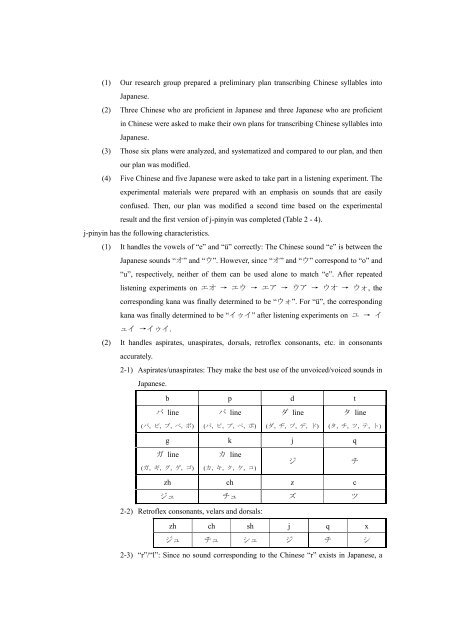j-pinyin: A New Systematic Approach to the Japanese Transcription ...
j-pinyin: A New Systematic Approach to the Japanese Transcription ...
j-pinyin: A New Systematic Approach to the Japanese Transcription ...
You also want an ePaper? Increase the reach of your titles
YUMPU automatically turns print PDFs into web optimized ePapers that Google loves.
(1) Our research group prepared a preliminary plan transcribing Chinese syllables in<strong>to</strong><strong>Japanese</strong>.(2) Three Chinese who are proficient in <strong>Japanese</strong> and three <strong>Japanese</strong> who are proficientin Chinese were asked <strong>to</strong> make <strong>the</strong>ir own plans for transcribing Chinese syllables in<strong>to</strong><strong>Japanese</strong>.(3) Those six plans were analyzed, and systematized and compared <strong>to</strong> our plan, and <strong>the</strong>nour plan was modified.(4) Five Chinese and five <strong>Japanese</strong> were asked <strong>to</strong> take part in a listening experiment. Theexperimental materials were prepared with an emphasis on sounds that are easilyconfused. Then, our plan was modified a second time based on <strong>the</strong> experimentalresult and <strong>the</strong> first version of j-<strong>pinyin</strong> was completed (Table 2 - 4).j-<strong>pinyin</strong> has <strong>the</strong> following characteristics.(1) It handles <strong>the</strong> vowels of “e” and “ü” correctly: The Chinese sound “e” is between <strong>the</strong><strong>Japanese</strong> sounds “オ” and “ウ”. However, since “オ” and “ウ” correspond <strong>to</strong> “o” and“u”, respectively, nei<strong>the</strong>r of <strong>the</strong>m can be used alone <strong>to</strong> match “e”. After repeatedlistening experiments on エオ → エウ → エア → ウア → ウオ → ウォ, <strong>the</strong>corresponding kana was finally determined <strong>to</strong> be “ウォ”. For “ü”, <strong>the</strong> correspondingkana was finally determined <strong>to</strong> be “イゥイ” after listening experiments on ユ → イュイ →イゥイ.(2) It handles aspirates, unaspirates, dorsals, retroflex consonants, etc. in consonantsaccurately.2-1) Aspirates/unaspirates: They make <strong>the</strong> best use of <strong>the</strong> unvoiced/voiced sounds in<strong>Japanese</strong>.b p d tバ lineパ lineダ lineタ line(バ, ビ, ブ, ベ, ボ)(パ, ピ, プ, ペ, ポ)(ダ, ヂ, ヅ, デ, ド)(タ, チ, ツ, テ, ト)g k j qガ line(ガ, ギ, グ, ゲ, ゴ)カ line(カ, キ, ク, ケ, コ)ジチzh ch z cジュ チュ ズ ツ2-2) Retroflex consonants, velars and dorsals:zh ch sh j q xジュ チュ シュ ジ チ シ2-3) “r”/“l”: Since no sound corresponding <strong>to</strong> <strong>the</strong> Chinese “r” exists in <strong>Japanese</strong>, a


